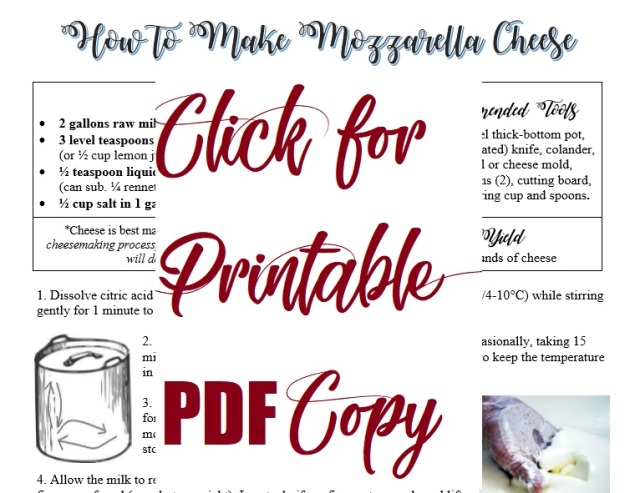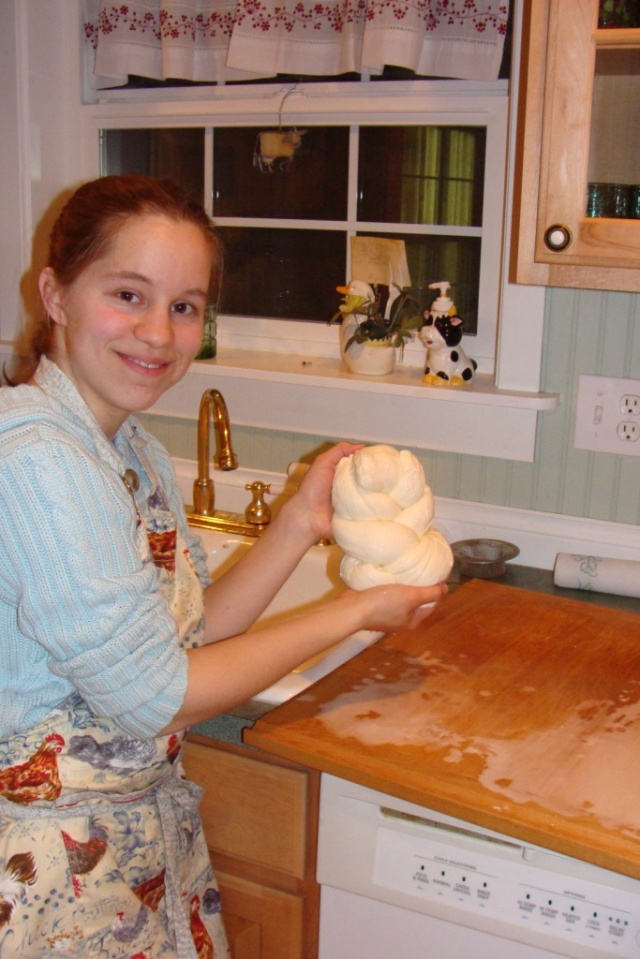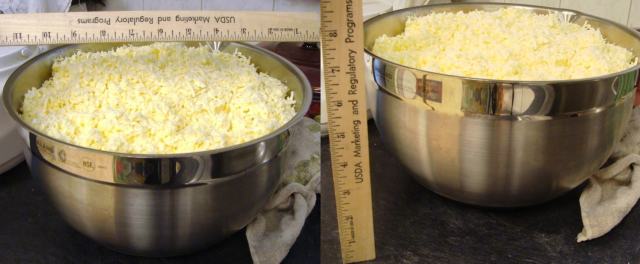
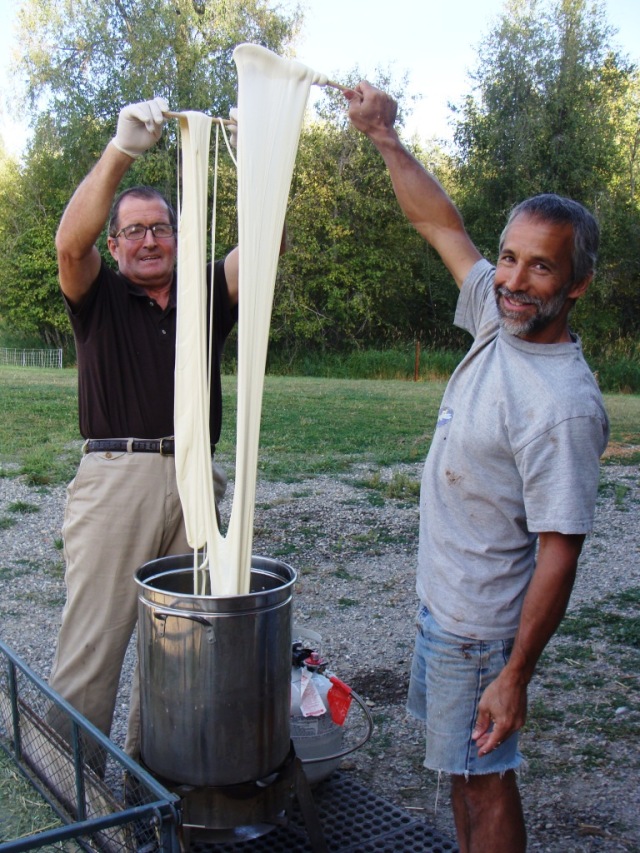
html format – updated April 2018
Ingredients
- 2 gallons raw milk or low-temp pasteurized milk*
- 3 level teaspoons citric acid powder in ¼ cup cool water
- (or ½ cup lemon juice + ¼ cup ACV)
- ½ teaspoon liquid rennet in ¼ cup cool water
- (can sub. ¼ rennet tablet)
- ½ cup salt in 1 gallon of water
*Cheese is best made from raw milk (pasteurizing inhibits the cheesemaking process). Pasteurized milk may be used, but final yield will decrease. Do not use UHT milk.
Recommended Tools
- stainless steel thick-bottom pot
- long (non-serrated) knife
- colander
- glass bowl or cheese mold
- wooden spoons (2)
- cutting board
- liquid measuring cup and spoons
Yield: 2-3 pounds of cheese (depending on initial components of milk)
-

Stir up/down and around to fully distribute the citric acid and later the rennet. Dissolve citric acid powder in cool water. Pour it slowly into cold milk (40-50°F/4-10°C) while stirring gently for 1 minute to disperse well.
- Heat the milk to 88°F (31.1°C) on medium-low heat, stir occasionally, taking 15 minutes to reach desired temp. When 88°F, turn off stove. Try to keep the temperature in the room warm so that the pot does not cool down too much.
- Dilute rennet in cool water. Gently stir rennet into milk for only 15-20 seconds with a top to bottom and clockwise motion (see illustration at right). End by slowing the milk to a stop.
-

Check curd for proper firmness before cutting the rest of the pot Allow the milk to remain still for 15 minutes while it coagulates. Check the firmness of curd (see photo on right). Insert a knife or finger at an angle and lift up. When the curd is ready, the cut will be clean and firm (not jagged or soft).
-
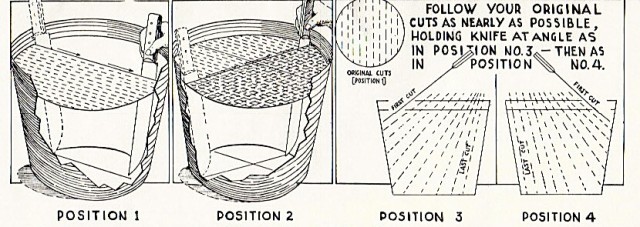
From CH Hansen poster Cutting the curd: Using a long knife, cut the solidified milk into ½” curds by following the illustration. The curd should cut easily and hold shape without falling apart. (If it falls apart, stop and wait a few more minutes.)
- Let curds remain undisturbed for 5-10 minutes to “heal”.
- Apply low heat and stir gently with a wooden spoon so as to keep curds separated. Slowly heat curds to around 104°F (40°C) within a 15-minute period. Shut off heat and continue to stir for an additional 15-20 minutes or until curds are finished. The curd will shrink and become denser as the whey is expelled – they will go from ½ inch squares down to large cottage cheese size. Use a knife to cut large curds into smaller sizes. The curds are ready when they all start to mat together. To test, pinch a piece of curd or grab a handful of curd and try to form a ball. The curd should form a ball and be elastic but not burst open, matte not glossy, sticky not slick.
-
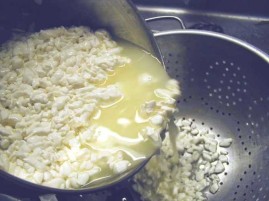
Draining curds of even size Pour curds into a colander (with a pot underneath if you want to collect the whey for ricotta). Set aside whey pot and put colander in the sink or in a large bowl to drain. Flip the curd once to help knit together the curd into one mass.
- In a large pot on the stove, mix ½ cup of pure salt into one gallon of water and heat to 170°F (76.7° C). Stir to dissolve salt. (Salt is added for flavor & as a preservative, but may be omitted if desired.)
-

Cut cheese from colander into long thin strips While the salt water is heating, move the curd onto a cutting board and cut into long 1” strips [see diagram at right]. If the strips are thick, lay strips on their side and cut as needed to make 1”x1” strips.
- When the water reaches 170°F, remove from heat and place somewhere with lots of head space for pulling the curd, like a kitchen island.
- Carefully place strips in the pot one at a time until all of the curd is in the pot. Using one or two wooden spoons, slowly lift the curds upward – use gravity to stretch the curds into mozzarella cheese. The cheese will begin to get ropy and shiny. Stretch for up to 10 minutes or until all of the lumps are smoothed out and the cheese is in one mass lump. Do not stretch longer than 10 min or the cheese may get tough.
You now have cheese instead of curds!
- Remove cheese from the water and place on counter if wanting to shape into small balls or a braid. Or place the whole ball of cheese into a glass bowl or cheese mold and set in cold or iced water until the cheese is cool and firm textured. Refrigerate once cool. It is now ready to eat!
Storage tips: Fresh Mozzarella cheese will taste good for up to a week if stored in the fridge. If made into small balls, can be stored in a brine solution. Mozzarella freezes well, so it is recommended to only keep out the amount that will get eaten fresh within a few days and immediately freeze the extra in blocks or shredded, to be pulled out as needed. (Freeze shredded cheese like you would berries: spread out shredded cheese on a lined baking sheet, place in freezer for an hour or two until frozen, break up the frozen cheese into little pieces. Store in a sealed container in freezer.)
For a firmer cutting cheese: pat dry, cover outside with a thin layer of salt, wrap in waxed paper, place in fridge for 24-48 hrs. Unwrap, rinse, and slice.
Illustrated recipe for making ricotta from the whey: https://fankhauserblog.wordpress.com/1982/02/22/ricotta-cheese-making-illustrated/
More Notes & Tips:
MOZZARELLA INGREDIENTS:
MILK –
- Why is “raw” milk best?
- Full fat provides flavor, color, and texture (low fat makes the cheese rubbery, translucent, dry, and tasteless).
- Raw milk has all the enzymes intact for proper digestion.
- Whole milk contains Vitamin B complex, Vitamin C, fat soluble vitamins A/D/E/K
- Whole milk is a complete food. You can skim the milk for a “dieters” meal, but then you lose the fat soluble vitamins and the benefits of “healthy” fats. A neighbor recently mentioned that her husband’s overall cholesterol had dropped significantly in the past 3 months since drinking fresh milk and cream and the good cholesterol had gone up!
- Pasteurized:
- Heat kills enzymes and destroys vitamins
- Heat damages the calcium phosphorus bond necessary to humans for absorbing calcium and necessary in the cheesemaking process for the creation of curds.
- If you must use pasteurized milk, you can add direct set cultures to improve flavor and calcium chloride to improve yield.
- Do not use ultra pasteurized milk, it’s not worth the low yield, if you get any yield.
- Homogenized:
- Further heat processes damage the milk
- Breaks up the butterfat into tiny particles (so they will no longer rise to the top and separate from the milk, for a consistent “white” appearance), but the tiny particles cannot be held in by the protein bonds.
- Do not ever use homogenized milk, it will not form into cheese.
CITRIC ACID –
- Look for labels that say 100% pure and Made in the USA
- If you do not want to use citric acid, you can experiment with lemon juice
- Or, you can add ½ teaspoon direct set culture OR ¼ cup fresh mother culture and let set several hours
RENNET –
- Beginners can use a Junket tablet from the store (most stores carry Junket near the jello/pudding)
- Calf rennet is the most reliable rennet and does not leave residual flavor.
- Pure calf rennet is made from the fourth stomach of calves that have only had milk and is “true” rennet.
- The secret you don’t hear about “vegetable” rennet is that it is actually a genetically modified microbial mold.
SALT –
- Use the purest you can find to avoid off flavors or colors
- Salt is a preservative and taste enhancer. Without salt, the “shelf life” of cheese is very short (a few days).
Whey Protein is high in Amino Acids, “whey protein” drinks are intended to be highly nutritious, but the fresh whey has the enzymes intact for proper digestion.
Where does the color come from?
- WHITE = casein (protein)
- YELLOW = keratin (butterfat)
More on Mozzarella:

- No Citric Acid? You can also acidify the milk by adding a 1/2 teaspoon of culture and letting the milk sit in the fridge overnight before starting the recipe. Start at step 3.
- Lemon juice can be used in place of citric acid – David Asher’s book (The Art of Natural Cheesemaking) contains a good recipe for lemon Mozzarella. I tried it and it came out successful & very tasty!
- Pasteurized milk? Even so, adding calcium chloride is not recommended for mozzarella, as it can affect the stretching process.
- Can’t eat it all right away? Mozarella freezes well. Try freezing a whole round, or cut into slices, or shred first and lay out on a baking sheet with wax paper underneath. When frozen, take off sheet and break up into little pieces. Store in a sealed container.
- My recipe is a close variation from the Instraella Mozzarella recipe! Come to a class and find out how it’s different!
- Any food grade plastic such as a cottage cheese container with holes poked in the side will make an excellent mold.
WANT TO SEE HOW THEY MAKE MOZZARELLA IN ITALY? http://www.mozzarelladop.it/index.php?section=prodotto&index=1 And then go to something like Google Translate to have the webpage translated to English. My parents visited there in 2009, and it was a highlight of their trip!


